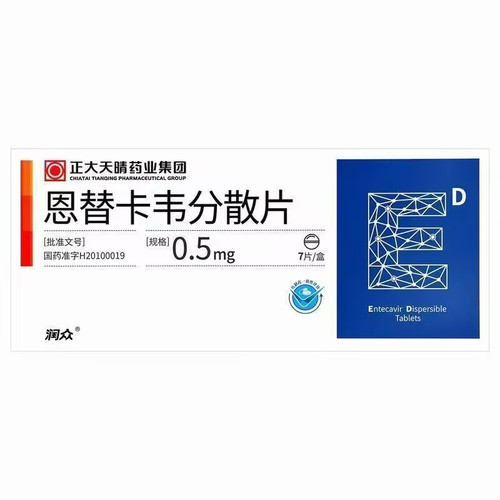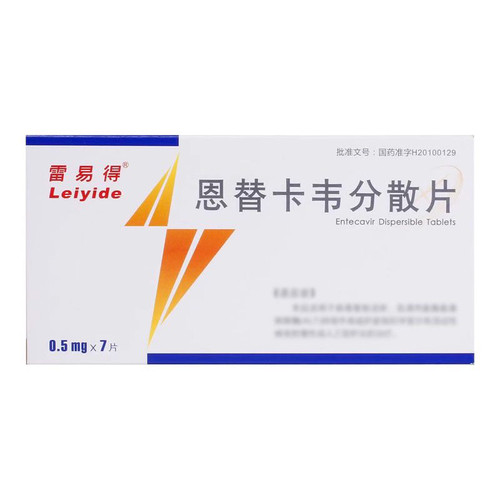Product Overview
[Drug Name]
Generic Name: Entecavir Dispersible Tablets
Trade Name: Heen
English Name: Entecavir Dispersible Tablets
Chinese Pinyin: Entecavir Dispersible Tablets
[Ingredients]
The main ingredient of this product is: Entecavir; Chemical Name: 2-Amino-9-[(1S,3R,4S)-4-hydroxy-3-hydroxymethyl-2-methylenecyclopentyl]-1,9-dihydro-6H-purin-6-one monohydrate.
[Properties]
This product is a white or off-white tablet.
[Indications]
This product is indicated for the treatment of chronic hepatitis B in adults with active viral replication, persistently elevated serum ALT, or active liver histological lesions.
[Dosage and Administration]
This product should be taken under the guidance of an experienced physician. Recommended Dose: Adults and adolescents aged 16 years and above should take 0.5 mg orally once daily. Patients who develop viremia or lamivudine-resistant mutations during lamivudine treatment should receive 1 mg (two 0.5 mg tablets) once daily. This drug should be taken on an empty stomach (at least 2 hours before or after a meal).
[Renal Insufficiency]
In patients with renal insufficiency, the apparent oral clearance of entecavir decreases with decreasing creatinine clearance (see Pharmacokinetics, Special Populations). The dose should be adjusted in patients with creatinine clearance < 50 mL/minute (including those receiving hemodialysis or CAPD).
[Hepatic Insufficiency]
No dose adjustment is required in patients with hepatic insufficiency.
[Treatment Duration]
The optimal duration of treatment with this drug and its relationship to long-term treatment outcomes, such as cirrhosis and liver cancer, are currently unknown.
[Adverse Reactions]
Adverse reactions were evaluated based on four global clinical trials: AI463014, AI463022, AI463026, and AI463027, as well as three clinical trials conducted in China (AI463012, AI463023, and AI463056). A total of 2,596 patients with chronic hepatitis B were enrolled in these seven studies. In studies comparing entecavir with lamivudine, adverse events and laboratory abnormalities were similar between entecavir and lamivudine. In international studies, the most common adverse events with entecavir were headache, fatigue, dizziness, and nausea. Common adverse events in patients treated with lamivudine were headache, fatigue, and dizziness. Across these four studies, 1% of entecavir-treated patients and 4% of lamivudine-treated patients discontinued the study due to adverse events and laboratory abnormalities, respectively.
[Contraindications]
1. Entecavir is contraindicated in patients allergic to entecavir or any of its ingredients. 2. The effects of entecavir on pregnant women are insufficiently studied. This product should only be used after a thorough balance of potential risks and benefits to the fetus has been made. 3. Currently, there is no data suggesting that this product can affect mother-to-child transmission of HBV. Therefore, appropriate interventions should be implemented to prevent neonatal HBV infection. 4. Entecavir is secreted in rat milk. However, whether it is secreted in human milk remains unclear. Therefore, breastfeeding is not recommended for mothers taking this product. 5. Due to a lack of sufficient clinical studies involving patients aged 65 years and older, it is unclear whether elderly patients respond differently to this product than younger patients. Other clinical trial reports have also failed to find differences between elderly and younger patients. Entecavir is primarily excreted by the kidneys, and the risk of toxic reactions may be higher in patients with renal impairment. Because elderly patients often have decreased renal function, careful dosage selection and renal function monitoring are important. [Precautions]
[Patients with renal insufficiency]
For patients with a creatinine clearance of 50 ml/min, including those on hemodialysis or CAPD, it is recommended that the entecavir dose be adjusted.
[Liver transplant recipients]
The safety and efficacy of entecavir in treating liver transplant recipients are unknown. If a liver transplant recipient is considered to require entecavir treatment and has been or is currently receiving immunosuppressive medications that may affect renal function, such as cyclosporine or tacrolimus, renal function should be closely monitored before and during entecavir administration.
[Patient Information]
Patients should take entecavir under the guidance of a physician and inform their physician of any new symptoms and concomitant medications. Patients should be informed that discontinuation of entecavir may worsen liver disease, so changes in treatment should be made under the guidance of a physician.Patients should undergo HIV antibody testing before starting entecavir treatment. Patients should be informed that if they are infected with HIV and are not receiving effective HIV drug treatment, entecavir may increase the risk of developing resistance to HIV drug treatment.Entecavir treatment does not reduce the risk of HBV transmission through sexual contact or contaminated blood. Therefore, appropriate protective measures need to be taken.
[Special Use]
Precautions for Use in Children:
Safety and efficacy data for this drug in children under 16 years of age have not been established.
Precautions for Pregnancy and Lactation:
The effects of entecavir on pregnant women are inadequately studied. This drug should only be used after a thorough balance of potential risks and benefits to the fetus. Currently, there are no data suggesting that this drug affects mother-to-child transmission of HBV. Therefore, appropriate interventions should be implemented to prevent neonatal HBV infection. Entecavir is secreted in rat milk. However, whether it is secreted in human milk remains unclear. Therefore, breastfeeding is not recommended for mothers taking this drug.
Precautions for Elderly Patients:
Due to a lack of adequate clinical studies involving patients aged 65 years and older, it is unclear whether elderly patients respond differently to this drug compared to younger patients. Other clinical trial reports have not found differences between elderly and younger patients. Entecavir is primarily excreted by the kidneys, and the risk of toxic reactions may be higher in patients with renal impairment. Because elderly patients often have decreased renal function, careful dosing and renal function monitoring are important.
[Drug Interactions]
Entecavir's metabolism was evaluated in vitro and in vivo. Entecavir is not a substrate, inhibitor, or inducer of the cytochrome P450 (CYP450) enzyme system. At concentrations approximately 10,000 times the human concentration, entecavir did not inhibit any of the major human CYP450 enzymes: 1A2, 2C9, 2C19, 2D6, 3A4, 2B6, and 2E1. At concentrations approximately 340 times the human concentration, entecavir did not induce the following human CYP450 enzymes: 1A2, 2C9, 2C19, 3A4, 3A5, and 2B6. Concomitant administration of drugs that are metabolized by CYP450 inhibitors or inducers did not affect the pharmacokinetics of entecavir. Furthermore, concomitant administration of entecavir did not affect the pharmacokinetics of known CYP substrates. Studies of the interaction between entecavir and lamivudine, adefovir, and tenofovir revealed no changes in the steady-state pharmacokinetics of either entecavir or the interacting drugs. Because entecavir is primarily eliminated through the kidneys, concurrent use of entecavir with drugs that reduce renal function or compete for active glomerular secretion may increase the plasma concentrations of these drugs. Concomitant administration of entecavir with lamivudine, adefovir, or tenofovir does not result in significant drug interactions. Concomitant interaction between entecavir and other drugs that are eliminated through the kidneys or are known to affect renal function has not been studied. Patients taking entecavir concomitantly with these drugs should be closely monitored for adverse reactions.
[Pharmacology]
This product is a guanine nucleoside analog that inhibits hepatitis B virus (HBV) polymerase. It is phosphorylated to its active triphosphate, which has an intracellular half-life of 15 hours. By competing with deoxyguanosine triphosphate, the natural substrate of HBV polymerase, entecavir triphosphate inhibits all three activities of viral polymerase (reverse transcriptase): (1) initiation of HBV polymerase; (2) formation of the negative strand of pregenomic mRNA reverse transcriptase; and (3) synthesis of the positive strand of HBV DNA. Entecavir triphosphate has a weak inhibitory effect on cellular alpha, beta, and delta DNA polymerases and mitochondrial gamma DNA polymerase, with Ki values ranging from 18 to greater than 160 μM.
[Storage] Sealed and stored in a dry place below 25°C.
[Specification] 0.5 mg * 7 tablets
[Packaging Specification] Box
[Expiration Period] 36 months
[Approval Number] National Medicine Standard H20100064
[Manufacturer] Company Name: Hainan Zhonghe Pharmaceutical Co., Ltd.







